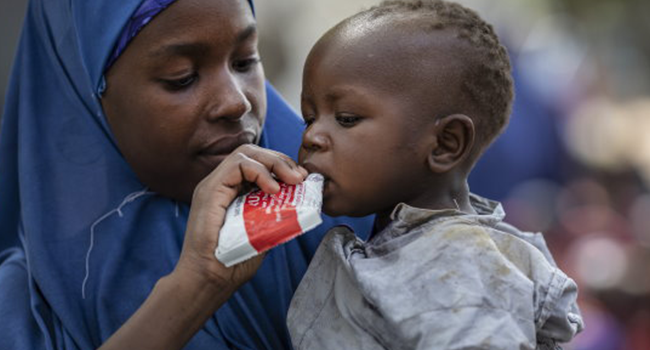Opinion
AYGF bridging the gap to healthy nutrition in Nigeria

By Chioma Iruke
Over the years, Nigeria as a country has suffered immensely from malnutrition despite being blessed with various natural resources, arable land, and economic potential.
As of 2018, the World Bank reported that Nigeria had about 37.33 % of arable land of which between January and March 2021, agriculture contributed to 22.35 per cent of the total Gross Domestic Product of the country.
Despite this, Nigeria has the second-highest burden of stunted children in the world, with a national prevalence rate of 32 per cent of children under five. Statistics from UNICEF declare an estimated 2 million children in Nigeria suffer from severe acute malnutrition (SAM).
This is quite disheartening for a country where 70 per cent of her households participate in crop farming activities, while about 41 per cent own or raise livestock.
According to data gotten by reliefweb.com, one out of two west Africans in need of food assistance lives in Nigeria and between 2016-2021, an average of 6.6million people in northern Nigeria were in urgent need of humanitarian and food assistance.
Although states in northern Nigeria are most affected by malnutrition, the south and west are not free from malnutrition as 0f 2018, 1.5 million children under five years in Nigeria’s South-west are said to be in dire need of intervention as of 2018.
Burdened with the state of nutrition in Nigeria, The Food and Agriculture Organization of the United Nations (FAO) birthed from the resolution of (resolution A/RES/73/251) of the General Assembly proclaimed in 2019 agreed with 10th February as the World Pulses Day.
Pulses are the legume branches or small plants that contain edible seeds that include beans, peas, chickpeas and lentils. Pulses are often harvested when the seeds become dry and are rich sources of protein.
They are very important crops because they contain a variety of nutrients and are an ideal and affordable source of protein for large sections of the population, especially in rural communities.
The day was adopted to increase public awareness of the nutritional and environmental benefits of pulses as part of sustainable food production. it has since been adopted by several governmental and Nongovernmental Organizations such as the Africa Youth Growth Foundation (AYGF) led by a veteran Civil Society actor Dr Salifu Arome.
Part of AYGF effort in promoting nutrition in Nigeria was her partnership with the World Bank on the Accelerating Nutrition Results in Nigeria (ARIN) project.
The project implemented by AYGF seeks to increase the utilization of quality, cost-effective nutrition services for pregnant and lactating women, adolescent girls and children under five years of age in 13 LGA and 139 Wards of Niger State as well as 21 Local Government Areas (LGA) and 239 wards in Kogi state.
Although, the Arin Project implemented by AYGF is aimed at scaling up Nutrition results in Nigeria, through the provision and utilization of quality Nutrition packages and services to pregnant women, lactating Mothers and under-five children in rural communities.
AYGF celebrated the recent World Pulse Day in Niger State by raising public awareness on the nutritional benefits of pulses crops and promoting their use and improving the intake of proteins among these categories of beneficiaries and beyond.
AYGF notes that Nigeria plays a significant role in global pulse production being among the top ten according to a statement by the Food and Agricultural Organization in 2016 and is the leading producer and consumer of cowpea in the world with 39% production in 2016-18 and is Nigeria’s major cultivated pulse accounting for 95.45% area and 97.55% of the pulse production in 2016-18. Recent research also suggests that 3.71 million tonnes of various pulse crops were cultivated in Nigeria as of 2020.
Nevertheless, the cowpea area has been diminishing, with a 30% loss at 3.5% yearly between 2006-08 and 2016-18. The production appreciated by 40% as observed from 1996-98 due to an increase in yield. Overall, Nigeria’s cowpea production is marked with fluctuations/stagnation.
Cowpea area, yield and production received steady and remarkable positive growth in places like Niger (73% at 2.8%, 213% at 5.9%, and 428% at 8.7% annually, respectively).
Per capita availability of pulses in Nigeria is over 10 times less than cereals and roots/tubers; hence, pulses contribute poorly to daily calorie and protein intakes. They are mainly utilized as cooked beans and steamed/fried pastes.
Despite being amongst the top ten producers of pulses in the world, experts believe a lot has to be done and has thus called on Nigerian farmers to attach great importance to pulses because of their importance to human nutrition and the nation’s food security as low pulse consumption is seriously contributing to nutritional problems in Nigeria.
Chioma Iruke works for the African Youth Growth Foundation in Abuja, she wrote this piece in commemoration of the World Pulse Day, 2022.
Disclaimer
It is the policy of NewsWireNGR not to endorse or oppose any opinion expressed by a User or Content provided by a User, Contributor, or other independent party. Opinion pieces and contributions are the opinions of the writers only and do not represent the opinions of NewsWireNGR.
Always visit NewsWireNGR for latest naija news and updated naija breaking news.
NewsWireNGR Latest News in Nigeria
Send Us A Press Statement/News Tips on 9ja Happenings: [email protected]
Advertise With Us: [email protected]
